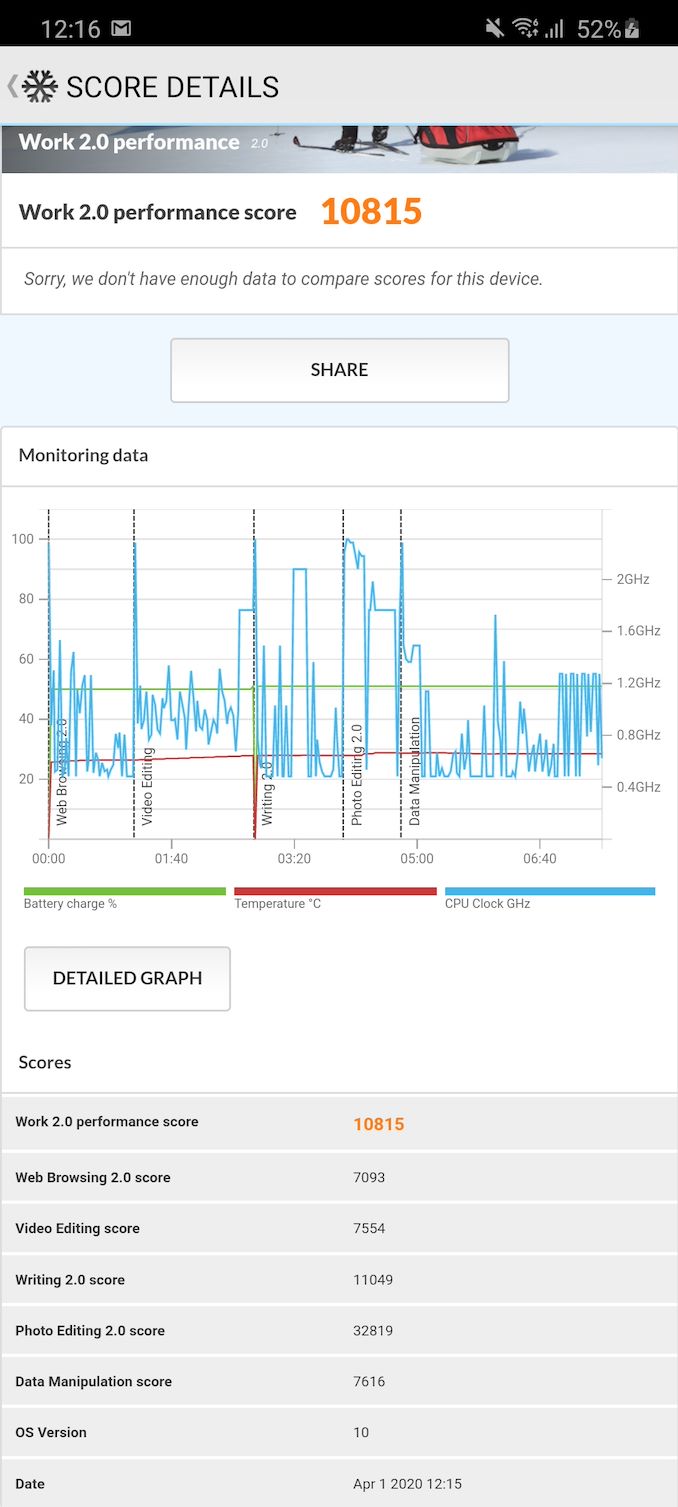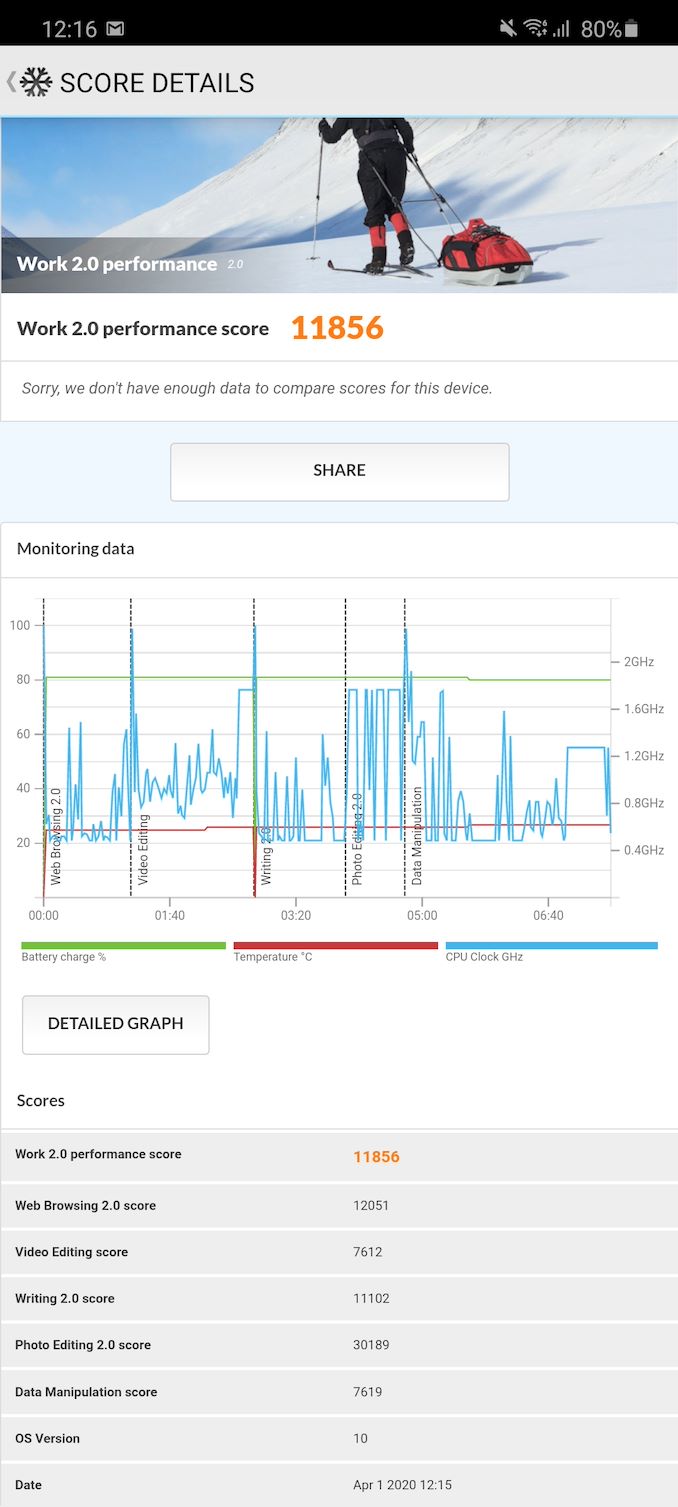The Samsung Galaxy S20+, S20 Ultra Exynos & Snapdragon Review: Megalomania Devices
by Andrei Frumusanu on April 3, 2020 9:30 AM ESTSystem Performance: 120Hz Winner
Although the peak CPU performance of the two Galaxy S20 SoCs isn’t all that different, what also matters is how the software decides to use that computing power. We’ve seen in the past that the DVFS and scheduler settings can have a very big impact on everyday performance of a device, sometimes even more so than the actual hardware. We’ve already quickly visited the Snapdragon 865 in the Galaxy S20 Ultra a few weeks ago, and we were very impressed by the performance and efficiency of the device. Now what remains to be seen how the Exynos 990 variant of the phone behaves.
Also at play here is the phone’s 120Hz display refresh mode. Samsung gives the option to choose between 60Hz and 120Hz in the display settings, with the latter naturally giving you more fluidity in applications. Beyond that, there’s also the matter of the device’s battery modes, in particular the difference between the default “Optimized” and “Performance” modes.
On past Samsung devices we’ve always tested the phones in their performance modes, as I hadn’t really noted much of a battery life difference between the two modes – and naturally we want to experience the full performance of a flagship device anyhow. This is still valid for the Snapdragon 865 Galaxy S20s, however the Exynos 990’s Performance mode is behaving weirdly and incurs quite a large power penalty, to the point that I would strongly recommend against using it. So the most practical comparisons for most people will be the Snapdragon Performance mode figures (P) against the default Exynos figures, at least for the S20 and at least for the current firmware versions.

Starting off in the web browsing test in PCMark, there’s a very clear performance difference between the two phones, however this isn’t just because the Exynos 990 somehow sucks, but because there’s a weird software configuration on the S20 Ultra.


Exynos 990 - Galaxy S20 Ultra 120Hz vs Galaxy S20+ 120Hz
Oddly enough the web browsing test is the most sensitive to a DVFS, scheduler, or Android task management setting difference between the Exynos S20 Ultra and the S20+. The latter here performs significantly better for some reason.

In the video editing test, the differences are minor, and in general the 120Hz results of the phones are clearly different to the 60Hz results. The test is generally V-sync limited here and isn’t all that representative of workloads anymore as most phones ace it nowadays. It’s again the Exynos in the 60Hz Performance mode which stands out of the crowd, getting better scores due to its extremely aggressive scheduling.

The Writing subtest is amongst the most important in the suite and most representative of everyday performance. Here the Snapdragon 865 is ahead of the Exynos by a good margin, and falls in line with the best scores we saw on the QRD865 in Performance mode. The Exynos, generationally, is also posting a good improvement over the Exynos 9820 of the Galaxy S10.

It seems SLSI has finally resolved their performance issues of their Renderscript drivers – either that, or the new Mali-G77 GPU is doing significantly better than the G76 in these workloads. Both variants of the S20 phones here clearly ends up with top performance scores, leading the pack ahead of all other Android devices.

In the Data Manipulation test, the scores are again quite good for both variants of the phone, however the Snapdragon 865 model does lead here, especially in the 120Hz mode. In fact, in this test it fares quite a lot better than the QRD865.

In the overall scores, both variants of the S20 Ultra are top performers. As a reminder, the Exynos 990 S20+ fared a bit better than our Ultra unit for some reason, but we’re opting to show the two Ultra scores here for best apples-to-apples between phones.
Web Benchmarks

In Speedometer 2.0, performance of the Exynos 990 chip isn’t all that much better than its predecessor, only sporting 12% increase. The Snapdragon variant on the other hand is 31% ahead of its S10 sibling, also posting notably better than what we had measured on the QRD865. It’s still far away from what Apple’s microarchitectures are able to achieve – the combination of strong CPUs along with better optimized browser JS engines is key to the iPhone performance.

In WebXPRT, the situation again favors the Snapdragon 865 variant of the phone by 17%.

Finally, in JetStream 2, the extend its lead to 24% which is quite large. Samsung’s custom CPU cores are particularly weak here and that’s likely due to the high instruction throughput of the test. I had found out their microarchitecture is quite weak with larger code sizes, for example unrolling loops will greatly handicap the performance of the Exynos CPUs whilst the Arm cores essentially see no big differences.
Performance Verdict: Both Winners, 120Hz Overshadows SoC Differences
Overall, I wasn’t disappointed with either variant of the S20. Both phones felt faster than Snapdragon 855 devices, the Snapdragon 865 variant of the S20 Ultra was just a little faster than the Exynos 990 variant.
The biggest improvement is user experience though it’s the 120Hz display mode. It’s just a fantastic addition to the phones, and really makes scrolling content that much more fluid. Along with the 240Hz touch input sampling rate of the phones makes these by far the most responsive and smooth experiences you can get on a mobile phone today.










137 Comments
View All Comments
katakuri4744 - Wednesday, April 8, 2020 - link
Hi Andrei,Appreciate such a detailed article. I have one question, how did you pull the voltage curve, is there a command?
I had S10 exynos then upgraded it to S20+ exynos, both the articles had this voltage curve though the Snapdragon variant does not, I would like to check the same for my device as well.
helloworld_chip - Monday, April 6, 2020 - link
Though 865's compute efficiency loks pretty good, from some other data points I heard that its infrastructure power (impacting real user-daily activities, light-loaded scenarios) is quite BAD. Would be good if more such comparisons are available to confirm this, since it determines how long people can actually use a phone.s.yu - Monday, April 6, 2020 - link
Idle is relatively inefficient and the numbers here show.helloworld_chip - Monday, April 6, 2020 - link
Gotcha thx.I am thinking we should calculate bat-capacity / hours instead of just hours to really show how is the SoCs overall efficiency.
Bigger and Bigger battery really make us feel heavier, we should push the designer harder to make these more efficiency instead of just using larger and larger battery.
FunBunny2 - Tuesday, April 7, 2020 - link
"Bigger and Bigger battery really make us feel heavier, we should push the designer harder to make these more efficiency instead of just using larger and larger battery. "last time I looked, most of the battery goes to driving the screen. so resurrect your original iPhone. the notion that batteries will have increasing power density this millennium is fantasy. Li is the smallest source of electrons available. well, unless you're willing to carry around a Hindenburg in your pocket.
s.yu - Tuesday, April 7, 2020 - link
Technically I'm with you but I just don't trust all developers to sufficiently optimize their code. You see that Peachncream guy who always claims that his dinosaur fossils run everything smoothly but it just doesn't happen to me. The way it is my S6E(backup device) that literally runs 3 apps in all(not even simultaneously, AFAIK) with animations turned off in dev mode is much slower than his...some really old low end phone, same thing with the battery, a large capacity gives me peace of mind over any optimization because I know that nothing could eat through the battery too fast.watzupken - Monday, April 6, 2020 - link
This is the reason why I will not consider any Samsung Galaxy phone that is running on Exynos SOC. If it is on the low/ mid end, I can't complain about it. But when shelling out for a flagship, I don't see why one would pay the same amount for the slower variant and you don't have the choice to get the superior version locally.andyfrut - Monday, April 6, 2020 - link
Is the S20+ (855) comparable with the S20 Ultra (855) in battery life in 120hz?andyfrut - Monday, April 6, 2020 - link
snapdragon 865*Ayaan_G - Tuesday, April 7, 2020 - link
The 5G addition to the Samsung Galaxy series will really give it a boost in another level !